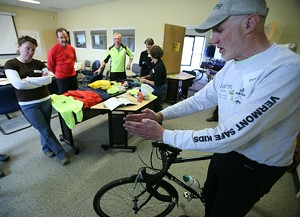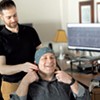Published April 29, 2009 at 9:46 a.m.
Cycling enthusiast Bob Britt of South Burlington almost didn’t make it to a bicycle safety course last Saturday in Burlington. He was just minutes from the Department of Public Works when a driver at the intersection of Pine Street and Flynn Avenue failed to stop at the blinking red light and nearly ran into him. Thankfully, Britt had a good set of brakes.
There were plenty of close-call stories from the dozen or so other cyclists who signed up for “Traffic Skills 101,” an eight-hour bicycle safety course presented by the nonprofit groups Local Motion and the Vermont Bicycle and Pedestrian Coalition. Riders told of motorists who were driving too fast, distracted by cellphones or iPods, and others just plain oblivious to the concept of sharing the road.
None of the bicyclists critiqued their own maneuvers — more on that later.
With more than 85 million cyclists expected to hit American roads in the next few weeks, the overarching theme of this course was readily apparent: to minimize the chances of becoming a casualty in the transportation wars. Each year, about 580,000 people end up in emergency rooms due to cycling crashes. Of them, about 67,000 suffer head injuries, 27,000 are hospitalized and about 800 die — mostly due to collisions with cars. Four out of five of those deaths could have been prevented had the cyclist been wearing a helmet, according to the Centers for Disease Control and Prevention.
The emergency room at Burlington’s Fletcher Allen Health Care typically sees between 10 and 15 bike accidents on a warm spring weekend, according to the medical director of the emergency department. Dr. Stephen Leffler says the classic victim is a male, between nine and 14 years old, who is riding in the early evening without a helmet.
The timing of the Saturday class coincided with a soon-to-be-launched public-safety campaign. The “Safe Streets Collaborative” is a multipronged effort to make Burlington’s streets safer for all users — cyclists, motorists, pedestrians, skateboarders and inline skaters. In 2010, the program will expand to all of Chittenden County, and eventually to the entire state.
Traffic Skills 101, which drew riders from as far as Sharon and Bennington, was designed for cyclists of all ages and skill levels — from experienced riders who’ve led bicycle tours through Europe, to rank amateurs like Ed Wise of Winooski, who’s relatively new to the sport. “I’m not a smart rider,” he told the class. “I guess I’m here to save my life and, hopefully, save someone else’s.”
Others attended to perfect their riding skills and gain more self-confidence on the roads, including Linda Olson of Poultney, who just started biking again after a bad spill last year.
For about four hours, course instructors Nancy Schulz and David Jacobowitz led the group through the fundamentals of bike safety in the classroom. They covered such basics as choosing the right-sized bike and helmet, conducting pre-ride equipment and maintenance checks, and repairing flat tires — far from the flow of traffic. The instructors, both seasoned riders, also offered some helpful tips, from wearing a heat-trapping shower cap under your helmet in the winter, to using an old chopstick on a derailed chain to avoid getting grease on your fingers.
When the classroom work was completed, it was time to saddle up and hit the road. The outdoor lessons began in a parking lot across the road, where Schulz and Jacobowitz led riders through a series of braking and maneuvering exercises meant to teach riders how to brake quickly, turn in dangerous situations and avoid potholes and other road hazards. Later in the day, the lessons focused on communicating effectively with drivers — through hand signals and eye contact — and predicting what they’ll do in various scenarios. Making a lefthand turn in multiple lanes of traffic? They covered that, too.
Cyclists tend to blame motorists for collisions with cars, but the numbers tell a different story. According to the League of American Bicyclists, 48 percent of all auto-bicycle collisions are caused by motorists, but 47 percent are the fault of the bike riders themselves. As Local Motion’s Executive Director Chapin Spencer points out, “It’s not a ‘bike thing’ or a ‘pedestrian thing’ anymore. It’s a traffic-safety thing. We all have a responsibility for our roadways to be safe.”
Spencer doesn’t even use the word “accident” anymore, as in his view most collisions could have been avoided. He points out that in Chittenden County last September, there were two hit-and-run bike collisions in two days. In one, the rider was young boy in South Burlington who was hit by a car cutting through a parking lot to avoid a red light. The driver was never identified.
In a second incident, University of Vermont cycling team member Rose Long was struck by a jeep on Pearl Street. According to court records, the driver, 22-year-old Adam Desjardin, fled the scene. Long suffered several broken bones and a serious eye injury, and has undergone several facial reconstructive surgeries. Last week, Desjardin pleaded no contest and now faces up to three years in prison.
“Those were two accidents in two days that were the most egregious examples of poor behavior and poor judgment” by drivers, Spencer says. However, he points out that many other incidents in recent years have been caused by pedestrians, skateboarders and cyclists making equally poor choices. Deputy Chief Walt Decker of the Burlington Police Department confirms that assessment. He recalls an elderly cyclist who was killed crossing against the light at the intersection of Manhattan Drive and Route 127 in Burlington. And no one can forget “Big John” Van Hazinga’s ill-fated ride down Route 108 on a skateboard two years ago.
The goal of the Safe Street Collaborative isn’t to assign blame but to offer both carrots and sticks. Local Motion and other partners in the collaborative will soon be out at pedestrian crosswalks handing out free food, brochures and coupons for safety gear and hands-free cellphone devices to walkers and riders who obey the rules.
Spencer says that the Burlington Police also will be out on the streets in full force this spring, stopping drivers, cyclists, skateboarders and, yes, even pedestrians who break the law. And they’ll be issuing many more tickets than in years past.
Why now? Spencer can’t say for sure, but he has a few theories. Part of it, he suspects, has to do with the growing popularity of digital devices — cellphones, mp3 players, GPS units and so forth — that have become ubiquitous distractions on the road.
Moreover, he says, many more people are complaining about the growing lack of civility on Vermont’s roads, among all users: “Cyclists are blowing through stop signs. Pedestrians aren’t using crosswalks. And motorists just aren’t paying attention.”
In May, the Safe Streets Collaborative also launches a toll-free hotline for citizens to report dangerous behavior. For example, if someone phones in the license plate of a car that’s failed to yield to a cyclist or pedestrian, the police have promised to follow up with the driver. Although officers won’t necessarily be able to ticket them, “Think of the 16-year-old driver who does something bad and then his parents get a phone call that night from the cops,” Spencer says. “We’ll be able to nip those problems in the bud.”
Finally, Spencer believes that Vermont is reaching a “tipping point” where more and more people are altering their transportation habits as part of a greater environmental ethic to drive less and reduce global warming. Last year, for example, Burton Snowboards launched a successful bike-commuting pool, which originates in Essex once a week and picks up employees along the way. This year, Spencer was invited to give a bike-commuting workshop at General Dynamics and Merchants Bank — two employers who’ve never expressed such interest in the past.
“I feel like we’re potentially at a real moment of change,” Spencer adds. “Whether we’re there or this is just a blip, we shall see.” Either way, he’s working to make sure that all the riders arrive alive.
Want to learn more?
The Vermont Bicycle & Pedestrian Coalition is offering Traffic Skills 101 on Saturday, May 16, in Montpelier. The all-day course, for novice and experienced bicyclists, is $55 including lunch. Preregister: 225-8904 or [email protected]. Click here for a course description.
Health and Fitness Issue
This is just one article from our April 29, 2009 Health and Fitness Issue. Click here for more Health and Fitness stories.
More By This Author
Speaking of...
-

'We Must Act Now': Burlington Council Passes Resolution on Drug Crisis, Public Safety
Oct 11, 2023 -

Three Vermont Schools Will Win a $100,000 Fitness Center
Mar 9, 2023 -

Video: Gail and George Africa of Vermont Flower Farm Plan to Retire
Sep 8, 2022 -

Under New Ownership, Turtle Fur Plans to Expand Its Offerings
Aug 1, 2022 -

Plunging Into Post-Pandemic Exercise With Aerial Dance
Jun 2, 2021 - More »
Comments
Comments are closed.
From 2014-2020, Seven Days allowed readers to comment on all stories posted on our website. While we've appreciated the suggestions and insights, right now Seven Days is prioritizing our core mission — producing high-quality, responsible local journalism — over moderating online debates between readers.
To criticize, correct or praise our reporting, please send us a letter to the editor or send us a tip. We’ll check it out and report the results.
Online comments may return when we have better tech tools for managing them. Thanks for reading.














































